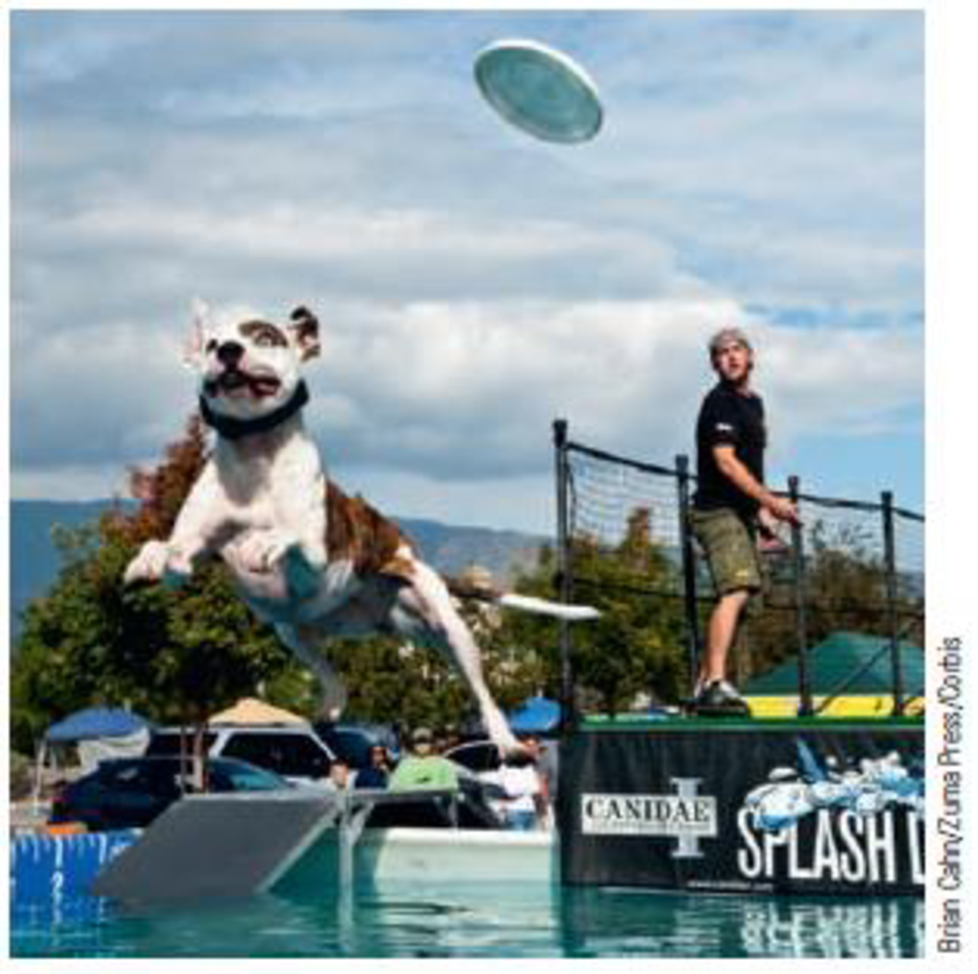
Concept explainers
Dock diving is a great form of athletic competition for dogs of all shapes and sizes (Fig. P4.33). Sheba, the American Pit Bull Terrier, runs and jumps off the dock with an initial speed of 9.02 m/s at an angle of 25° with respect to the surface of the water. a. If Sheba begins at a height of 0.84 m above the surface of the water, through what horizontal distance does she travel before hitting the surface of the water? b. Write an expression for the velocity of Sheba, in component form, the instant before she hits the water. c. Determine the peak height above the water reached by Sheba during her jump.

FIGURE P4.33
(a)
The horizontal distance travelled by Sheba before hitting the surface of the water.
Answer to Problem 33PQ
The horizontal distance travelled by Sheba before hitting the surface of the water is
Explanation of Solution
Sheba, the dog, is dock diving in an athletic competition for dogs and jumps off the dock with an initial speed of
Write the formula for the vertical position
Here,
Write the formula for the horizontal position
Here,
Sheba jumped from initial position
The vertical acceleration is due to gravity pulling the Sheba in direction downward,
Substituting
Solving the quadratic equation, the valuable root is
The time taken for Sheba to reach the water surface is
Substitute
Thus, the horizontal distance travelled by Sheba before hitting the surface of the water is
(b)
Write the velocity of Sheba at the instant before she hits the water in component form.
Answer to Problem 33PQ
The velocity of Sheba at the instant before she hits the water in component form is
Explanation of Solution
Write the formula for the velocity vector equation for the projectile motion
Here,
The horizontal velocity component is
The vertical velocity component is
Substituting in equation (III) to find the value of
Thus, the velocity of Sheba at the instant before she hits the water in component form is
(c)
The peak height above the water surface reached by Sheba during her jump.
Answer to Problem 33PQ
The peak height above the water surface reached by Sheba during her jump is
Explanation of Solution
Write the formula for the vertical velocity component for the projectile motion
The initial vertical velocity of Sheba is
Substituting
The time taken for Sheba to reach the peak height is
Substituting
Thus, the peak height above the water surface reached by Sheba during her jump is
Want to see more full solutions like this?
Chapter 4 Solutions
Physics for Scientists and Engineers: Foundations and Connections
- 2. Consider the situation described in problem 1 where light emerges horizontally from ground level. Take k = 0.0020 m' and no = 1.0001 and find at which horizontal distance, x, the ray reaches a height of y = 1.5 m.arrow_forward2-3. Consider the situation of the reflection of a pulse at the interface of two string described in the previous problem. In addition to the net disturbances being equal at the junction, the slope of the net disturbances must also be equal at the junction at all times. Given that p1 = 4.0 g/m, H2 = 9.0 g/m and Aj = 0.50 cm find 2. A, (Answer: -0.10 cm) and 3. Ay. (Answer: 0.40 cm)please I need to show all work step by step problems 2 and 3arrow_forwardFrom number 2 and 3 I just want to show all problems step by step please do not short cut look for formulaarrow_forward
- Look at the answer and please show all work step by steparrow_forward3. As a woman, who's eyes are h = 1.5 m above the ground, looks down the road sees a tree with height H = 9.0 m. Below the tree is what appears to be a reflection of the tree. The observation of this apparent reflection gives the illusion of water on the roadway. This effect is commonly called a mirage. Use the results of questions 1 and 2 and the principle of ray reversibility to analyze the diagram below. Assume that light leaving the top of the tree bends toward the horizontal until it just grazes ground level. After that, the ray bends upward eventually reaching the woman's eyes. The woman interprets this incoming light as if it came from an image of the tree. Determine the size, H', of the image. (Answer 8.8 m) please show all work step by steparrow_forwardNo chatgpt pls will upvotearrow_forward
 Principles of Physics: A Calculus-Based TextPhysicsISBN:9781133104261Author:Raymond A. Serway, John W. JewettPublisher:Cengage Learning
Principles of Physics: A Calculus-Based TextPhysicsISBN:9781133104261Author:Raymond A. Serway, John W. JewettPublisher:Cengage Learning Physics for Scientists and Engineers: Foundations...PhysicsISBN:9781133939146Author:Katz, Debora M.Publisher:Cengage Learning
Physics for Scientists and Engineers: Foundations...PhysicsISBN:9781133939146Author:Katz, Debora M.Publisher:Cengage Learning Physics for Scientists and Engineers with Modern ...PhysicsISBN:9781337553292Author:Raymond A. Serway, John W. JewettPublisher:Cengage Learning
Physics for Scientists and Engineers with Modern ...PhysicsISBN:9781337553292Author:Raymond A. Serway, John W. JewettPublisher:Cengage Learning


